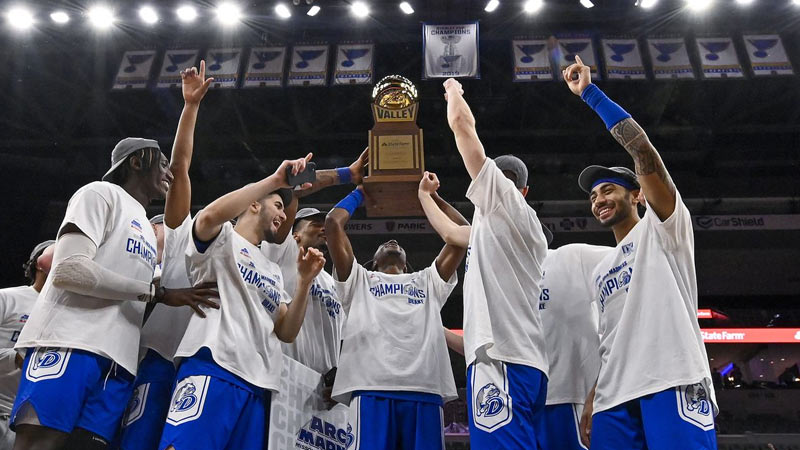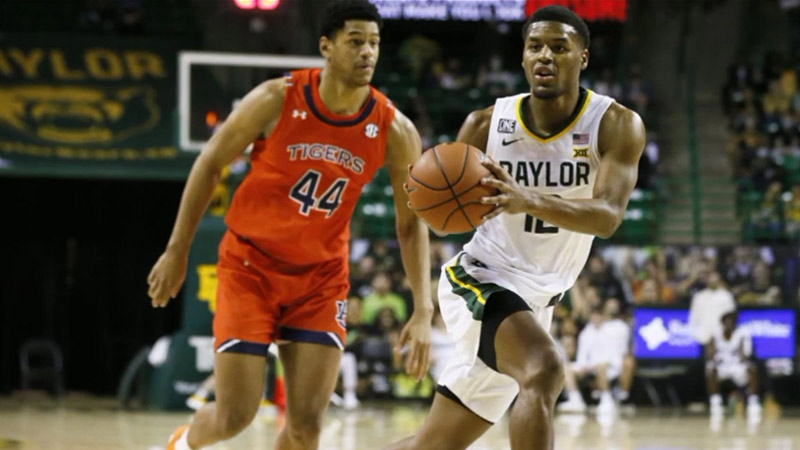March Madness, the NCAA Men’s Basketball Tournament, is a thrilling and highly anticipated event that showcases the best college basketball teams in the nation.
One key aspect of the tournament is the concept of an “automatic bid.” In this blog post, we will explore what an automatic bid in March Madness means, how it is earned, and its significance in the tournament.
The concept of automatic bids will provide insight into the selection process and the opportunities available to teams from various conferences to secure their place in the tournament. So, stay focused.
What Is An Automatic Bid In March Madness?
An automatic bid in March Madness refers to a guaranteed entry into the NCAA Men’s Basketball Tournament for a team that wins its conference tournament. It is a coveted opportunity for teams to secure their place in the tournament by achieving success within their respective conferences.
In this section, we will delve deeper into the concept of an automatic bid, its significance, and how it differs from at-large bids. An automatic bid is essentially a ticket to March Madness earned through the accomplishment of winning a conference tournament.
Each conference, regardless of its size or competitiveness, is allocated an automatic bid, ensuring that teams from all conferences have an opportunity to participate in the tournament.
The automatic bid provides teams with the assurance of a spot in the NCAA Tournament and the chance to compete against other conference champions.
How Do You Get an Automatic Bid for March Madness?

Source: si.com
To secure an automatic bid for March Madness, a team must navigate the conference tournament and emerge as the champion.
This section will delve deeper into the process of earning an automatic bid and the significance of conference tournaments in determining the teams that advance to the NCAA Tournament.
Regular Season Conference Play
The road to earning an automatic bid begins with the regular season conference play. Teams compete against one another in a series of conference games to establish their positions within the conference standings.
These games determine the seeds and positioning of teams heading into the conference tournament.
Conference Tournaments
Conference tournaments are the battlegrounds where teams compete for the conference championship and the accompanying automatic bid. These tournaments typically take place after the regular season and feature a single-elimination format.
The specifics of each conference tournament may vary, including the number of teams involved, the tournament format, and the venue.
Single-Elimination Format
In a single-elimination format, teams face off against one another, and only the winners of each game continue to advance in the tournament. The losing teams are eliminated from further competition.
This format adds intensity and pressure to each game, as teams must perform at their best to continue their journey toward the conference championship.
Determining the Conference Champion
The team that emerges as the champion of the conference tournament earns the automatic bid for March Madness. This is achieved by winning the championship game, which is often the culmination of several days of intense competition.
The conference champion is recognized as the best team within their conference, securing their place in the NCAA Tournament.
Recognition of Success and Performance
The automatic bid rewards teams for their success within their respective conferences. It acknowledges their ability to perform under the high-stakes pressure of the conference tournament and recognizes their accomplishments throughout the regular season.
The automatic bid serves as a tangible representation of the team’s hard work, dedication, and performance.
How Many Automatic Bids to NCAA?

Source: dknetwork.draftkings.com
In total, there are 32 automatic bids in the NCAA Men’s Basketball Tournament. This number corresponds to the number of conferences that receive an automatic bid for their tournament champion.
These conferences encompass a wide range of sizes, competitiveness, and geographic locations, ensuring representation from various regions across the country.
The 32 automatic bids make up a significant portion of the 68-team tournament field. The remaining teams in the field, up to a total of 36, are selected through at-large bids.
At-large bids are determined by the NCAA selection committee, which evaluates teams based on their overall performance, strength of schedule, and other factors.
These at-large bids provide opportunities for teams that may not have won their conference tournament but have demonstrated strong performance throughout the season.
Conference Tournaments of Automatic Bid In March Madness
Conference tournaments are an integral part of the road to March Madness. These tournaments serve as the ultimate battleground for teams vying for automatic bids.
They provide an opportunity for teams within the same conference to compete against each other and determine the conference champion.
Single-Elimination Format
Conference tournaments follow a single-elimination format, where teams face off in a series of games until a champion is crowned.
The pressure is high, as one loss can end a team’s chance of securing the automatic bid. This format adds intensity and drama to the tournament, with teams giving their all to come out on top.
Structure and Duration of Conference Tournaments
The structure and duration of conference tournaments vary across conferences. Some conferences include all teams in the tournament, while others involve only a subset of teams based on conference standings.
The duration of the tournaments also varies, with some taking place over a few days and others spanning a week or more.
Determining the Conference Champion
In conference tournaments, teams compete in bracket-style matchups, with winners advancing to the next round. The final game determines the conference champion, who will receive the automatic bid to March Madness.
The conference champion’s victory in the tournament showcases their dominance within the conference and earns them the opportunity to represent their conference on the national stage.
History of Automatic Bid In March Madness
In the early years of the NCAA Tournament, there were fewer teams and no automatic bids.
The tournament primarily consisted of conference champions, with only a limited number of at-large teams receiving invitations. This format often resulted in power conferences dominating the tournament.
Automatic Bids
As the tournament field expanded and more conferences were included, the introduction of automatic bids became necessary to ensure fair representation from all conferences.
In 1975, the tournament field expanded to 32 teams, allowing for more conference champions to participate. Automatic bids provided an opportunity for teams from conferences of all sizes and reputations to compete in March Madness.
The Expansion to 68 Teams and the First Four
The tournament continued to expand, reaching 68 teams in 2011. With this expansion, the First Four, a play-in round, was introduced. The First Four consists of four games that determine the final four teams to enter the round of 64.
The remaining teams earn automatic bids or at-large bids based on their performance and the selection committee’s evaluation.
Inclusivity and Opportunities for Smaller Conferences
The inclusion of automatic bids in March Madness has had a profound impact on the tournament’s inclusivity. Smaller conferences now have a fair chance to compete on a national stage and potentially upset teams from power conferences.
Automatic bids have given rise to Cinderella stories, where underdog teams capture the nation’s attention by defying expectations and advancing deep into the tournament.
Enriching the Tournament’s History
Automatic bids have become an integral part of March Madness’ rich history. They have allowed for the emergence of memorable moments, upsets, and underdog stories that captivate fans.
The inclusion of teams from various conferences adds excitement and unpredictability to the bracket, making the tournament a thrilling and inclusive experience for basketball enthusiasts.
Significance of Automatic Bid In March Madness
Some of the main significance of automatic bids in March Madness is discussed in the following part. Check them out now.
Ensuring Representation at All Conferences
The automatic bid holds immense significance in March Madness as it guarantees representation from all conferences. By providing an automatic bid to each conference, the NCAA recognizes the value and contribution of teams from various regions and conferences, fostering inclusivity in the tournament.
This allows teams from smaller or lesser-known conferences to compete against powerhouse programs, leveling the playing field and providing equal opportunities for teams across the country.
Creating Excitement and Anticipation
Automatic bids create a sense of excitement and anticipation within conferences. The conference tournaments become the pinnacle of the regular season, where teams put forth their best efforts to claim the automatic bid and the chance to compete on a national stage.
The stakes are high, and the tournament atmosphere intensifies as teams battle for the opportunity to represent their conference in March Madness. The automatic bid adds an extra layer of drama and motivation for teams, elevating the significance of conference tournaments.
Rewarding Performance within Conferences
The automatic bid serves as a reward for teams that perform well within their conferences throughout the season. It acknowledges their accomplishments and recognizes their ability to rise to the occasion in the conference tournament.
Winning the conference tournament and securing the automatic bid validate a team’s consistent performance, resilience, and ability to compete at a high level within their conference. It serves as a culmination of their efforts and provides a tangible reward for their success.
Exposure and Recognition for Smaller Conferences
For teams from smaller or lesser-known conferences, the automatic bid provides exposure and recognition. It offers a platform for these teams to showcase their talents on a national stage, potentially upsetting higher-seeded teams in the NCAA Tournament.
The automatic bid brings attention to conferences that may not receive the same level of exposure throughout the regular season, allowing them to make a statement and gain recognition for their accomplishments.
It offers an opportunity for teams from smaller conferences to create memorable Cinderella stories that captivate fans and generate widespread appreciation for their achievements.
Enhancing the Tournament Experience
The presence of teams from a variety of conferences, thanks to automatic bids, adds diversity and unpredictability to the tournament bracket. This diversity enhances the overall tournament experience for fans and viewers.
It creates compelling storylines and adds an element of surprise and excitement to March Madness. The inclusion of automatic bids has led to historic upsets and Cinderella runs, where underdog teams have defied expectations and captured the hearts of fans across the country.
These moments of triumph and surprise contribute to the tournament’s unique and captivating nature, making it an unforgettable spectacle.
FAQs
What is an automatic bid in March Madness?
An automatic bid is a guaranteed entry into the NCAA Tournament for a team that wins its conference tournament.
Each conference, from the major conferences like the ACC and Big Ten to smaller conferences, is allocated an automatic bid, giving the conference tournament champion a ticket to March Madness.
How is an automatic bid earned?
To earn an automatic bid, a team must win its conference tournament, which takes place at the end of the regular season.
The conference tournament typically includes teams from the same conference competing in a single-elimination format until a champion is crowned.
The winning team receives the automatic bid and secures a spot in the NCAA Tournament.
What is the purpose of automatic bids?
Automatic bids ensure that each conference has representation in the NCAA Tournament. It provides an opportunity for teams from smaller or lesser-known conferences to showcase their skills on a national stage.
It adds diversity and ensures that the tournament is inclusive, allowing teams from different conferences to compete against each other.
How many automatic bids are there in March Madness?
There are a total of 32 automatic bids in March Madness. This corresponds to the number of conferences that receive an automatic bid for their tournament champion.
The remaining teams in the tournament field, up to a total of 68 teams, are selected through at-large bids, which are determined by the NCAA selection committee.
What happens if a team that earns an automatic bid also receives an at-large bid?
If a team wins its conference tournament and earns an automatic bid but is also deemed strong enough by the selection committee to receive an at-large bid, the team will still receive its automatic bid.
In this case, another team from the same conference may receive an at-large bid instead, allowing more teams from the conference to participate in the tournament.
Conclusion
Automatic bids play a vital role in the NCAA Men’s Basketball Tournament, allowing teams to earn their spot in March Madness by winning their respective conference tournaments.
These bids ensure representation from conferences of all sizes and provide opportunities for teams from lesser-known conferences to compete against powerhouse programs.
The concept of automatic bids adds excitement and diversity to the tournament, making March Madness a true showcase of collegiate basketball talent. Thank you so much.







